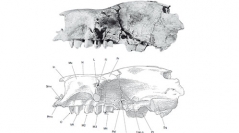

 Geodiversitas
32 (2) - Pages 255-306
Geodiversitas
32 (2) - Pages 255-306Two new Mylodontinae (Xenarthra, Tardigrada, Mylodontoidea) from the Bolivian Altiplano are described. One of them, Pleurolestodon dalenzae n. sp., was discovered a few meters below a volcanic tuff, Toba 76, that may be used as a reference stratigraphic level and is dated at 5.4 Ma; it could be Huayquerian (late Miocene) or at the Huayquerian-Montehermosan boundary in age. The other taxon, Simomylodon uccasamamensis n. gen., n. sp., was recovered from many localities of a horizon bounded below by Toba 76 and above by another volcanic level, the 2.8 Ma Ayo Ayo tuff ; its age is Montehermosan-Chapadmalalan (early and middle Pliocene). Analysis of these taxa indicates that they are Mylodontidae more closely related to Glossotherium, Glossotheridium, Kiyumylodon and Paramylodon than to Lestodon or Thinobadistes.
Mammalia, Xenarthra, Tardigrada, Mylodontidae, Neogene, Huayquerian, Montehermosan, Bolivian Altiplano, anatomy, new genus, new species